
L.S. Lowry The mill, Pendlebury 1943

Something I’ll try to write a separate article about later today, but that I would like to leave you with for now: Dr. Fauci, Trump’s main medical/epidemic advisor, said yesterday that 200,000 Americans could die from COVID19. The same Fauci, as I quoted two days ago, recently changed his case fatality rate prediction from 1% to 0.1%.
I had to let that sink in for a while, because if those 200,000 people represent that 0.1%, he now apparently believes that 200 million Americans could be infected with the coronavirus. The offical number of infected Americans right now according to Worldometer is 142,735. The offical death number is 2,489.
On top of that, Trump said, undoubtedly after conferring with Fauci among others, that the coronavirus peak in the USA is expected to take place in two weeks (Easter). You get where I’m going with this: how on earth are the numbers supposed to add up? In proven Trumpian fashion, Fauci did cover himself: “We’re going to have millions of cases.” But he added “I don’t want to be held to that” because the pandemic is “such a moving target.“ We’re going to have millions of cases, but don’t hold me to that…
I think most people see these numbers flash by without realizing what they mean.

• Cases 734,931 (+ 57,283 from yesterday’s 677,648)
• Deaths 34,780 (+ 3,043 from yesterday’s 31,737)

From Worldometer yesterday evening (before their day’s close)
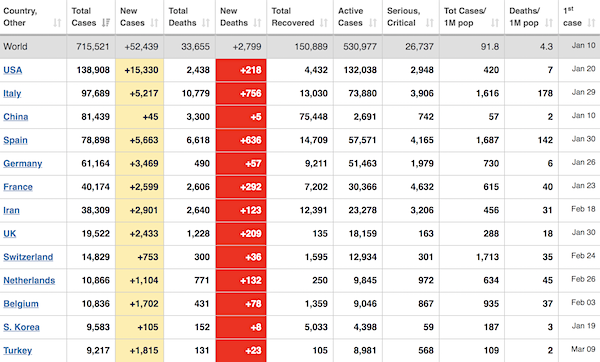
From Worldometer -NOTE: mortality rate for closed cases is at 18% –
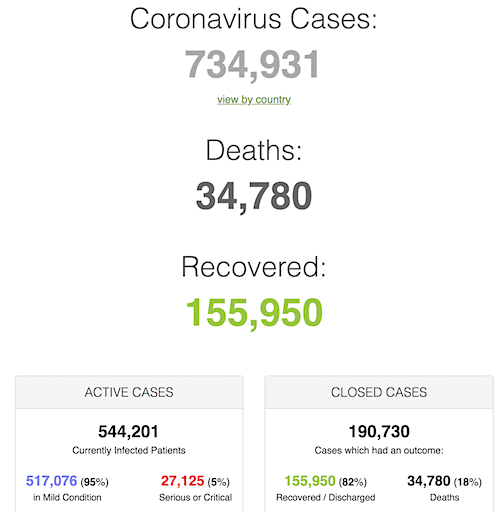
From SCMP:
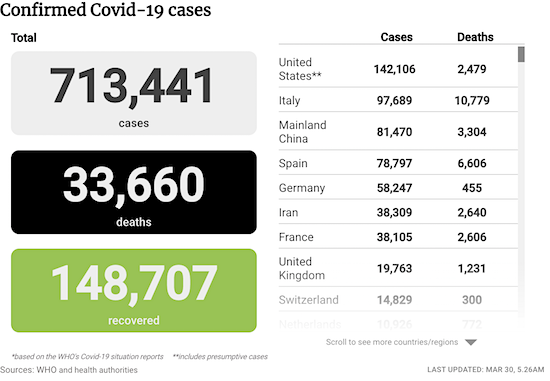
From COVID2019Live.info: (Note: Spain already has twice as many deaths as China, it will pass it in total cases too in a bit. Oh wait, it did as I wrote that)
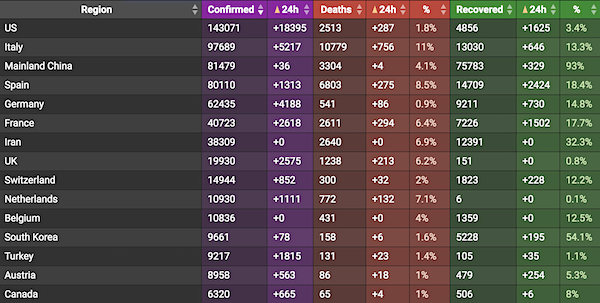

Wonder if he’s included the effects of a health care system collapse. Ironically, that might make his numbers more realistic.
• Dr. Fauci Says 200,000 Americans Could Die From The Coronavirus (MW)
The coronavirus outbreak could kill 100,000 to 200,000 Americans, the U.S. government’s top infectious-disease expert warned on Sunday as smoldering hot spots in nursing homes and a growing list of stricken cities heightened the sense of dread across the country. Dr. Anthony Fauci, director of the National Institute of Allergy and Infectious Diseases, made the dire prediction of fatalities on CNN, adding that millions in the U.S. could become infected. “I would say between 100,000 and 200,000 cases,” he said, correcting himself to say he meant deaths. “We’re going to have millions of cases.” But he added “I don’t want to be held to that” because the pandemic is “such a moving target.”
By evening, the U.S. had over 135,000 infections and 2,400 deaths, according to the running tally kept by Johns Hopkins University, though the true number of cases is thought to be considerably higher because of testing shortages and mild illnesses that have gone unreported. Worldwide, more than 710,000 infections were reported, and deaths topped 33,000, half of them in Italy and Spain, where hospitals are swamped and the health system is at the breaking point. New York state — where the death toll closed in on 1,000, up by more than 200 from the day before — remained the epicenter of the U.S. outbreak, with the vast majority of the deaths in New York City. But spikes in infections were recorded around the country, not only in metropolitan areas but in Midwestern towns and Rocky Mountain ski havens.
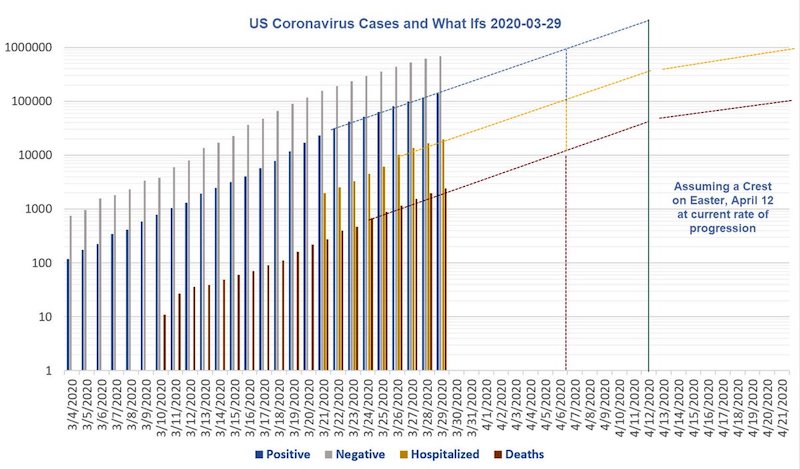
Graph by Mike Shedlock based on data from Covid Tracking Project.

A shutdown, not a lockdown, extended to April 30.
• Trump: Keeping US COVID-19 Deaths To 100,000 Would Be A ‘Very Good Job’ (G.)
Donald Trump has extended America’s national shutdown for a month, bowing to public health experts, and scientific reality, and warning that the worst of the coronavirus pandemic is yet to come. Speaking in the White House Rose Garden, the US president claimed that, if his administration keeps the death toll to 100,000, it will have done “a very good job” – a startling shift from his optimistic predictions of a few days ago when he said he hoped to restart the economy by Easter. Trump also undermined his plea for unity by uttering falsehoods, verbally abusing reporters and making incendiary allegations that implied health care workers were stealing masks, without providing evidence.
The extended deadline marked a humiliating retreat for the president who, having squandered six precious weeks at the start of the pandemic, more recently complained that the cure is worse than the problem and floated Easter Sunday as a “beautiful timeline” for reopening big swathes of the country. On Sunday he claimed this had only been “aspirational” as his advisers urged him not to move too hastily. He announced the initial 15-day period of social distancing urged by the federal government, which was due to expire on Monday, would be extended to 30 April, and said he hoped normality might return by 1 June.
The guidelines recommend against big group gatherings and urge older people and anyone with existing health problems to stay at home. People were also urged to work at home when possible and avoid restaurants, bars, non-essential travel and shopping trips. “The modelling estimates that the peak in death rate is likely to hit in two weeks,” Trump told reporters, with the toll already at more than 2,400. “Nothing would be worse than declaring victory before the victory is won. That would be the greatest loss of all.”

This is scary. Very. Add that 50% to all the people who are not admitted to an ICU in the first place, because their survival chances are deemed too low.
• Coronavirus Patients In UK Intensive Care Have 50% Survival Rate (G.)
The mortality rate for patients put in intensive care after being infected with Covid-19 is running at close to 50%, a report has revealed. Data from the Intensive Care National Audit and Research Centre (ICNARC) showed that of 165 patients treated in critical care in England, Wales and Northern Ireland since the end of February, 79 died, while 86 survived and were discharged. The figures were taken from an audit of 775 people who have been or are in critical care with the disease, across 285 intensive care units. The remaining 610 patients continue to receive intensive care. The high death rate raises questions about how effective critical care will be in saving the lives of people struck down by the disease.
As a top priority, the NHS is opening field hospitals in London, Birmingham and Manchester, which will incorporate some of the biggest critical care units ever seen in Britain. “The truth is that quite a lot of these individuals [in critical care] are going to die anyway and there is a fear that we are just ventilating them for the sake of it, for the sake of doing something for them, even though it won’t be effective. That’s a worry,” one doctor said. The report also found that though the majority of those who have died from coronavirus across the UK were over 70, nine of the 79 who died in intensive care were aged between 16 and 49, as were 28 of the 86 who survived.
The audit suggested that men are at much higher risk from the virus – seven in ten of all ICU patients were male, while 30% of men in critical care were under 60, compared to just 15% of women. Excess weight also appears to be a significant risk factor; over 70% of patients were overweight, obese or clinically obese on the body mass index scale. [..] The former health minister Dan Poulter, who works as a psychiatrist in wards with many cases of the virus, says widespread testing could be a “game-changer” that would prevent staff who are asymptomatic carriers of the virus from passing it on to patients in hospital for other reasons.
Widespread testing of those who are self-isolating with mild symptoms would also allow them to get back to work if they tested negative. Writing in the Observer, Poulter says: “NHS staff sickness levels are already high, and they are only going to increase as the Covid-19 outbreak intensifies. “Many of us are also worried that we may be infected, yet asymptomatic (showing no symptoms) and therefore could be a potential risk to our patients, colleagues and families. That is the last thing that we would want, but we simply do not know.

Long article, good snippet.
Asymptomatic, presymptomatic, paucisymptomatic, 40+% of cases is transmitted before symptoms develop. Much of this can be prevented if people wear masks, which should be worn to protect others, not -just- yourself. But that’s not what people are made to think they’re for. And anyway, where are the masks? There was a news item in Holland yesterday that 500,000 masks purchased from China and sent to hospitals had been returned because they were no good at all.
• What We Still Need To Know (Stat)
When people have a disease that is only contagious once they start to get sick, it’s much easier to order them to isolate themselves the moment they feel unwell. But that doesn’t work with this virus. A number of studies have reported that a significant portion of people are even spreading the virus while presymptomatic — in the day or two before they start to feel ill. Presymptomatic spreaders are, well, gonna spread. It’s not their fault. (It’s also why safe physical distancing — the preferred term for what you’ve seen described as social distancing — is important. It reduces the risk of presymptomatic spread.) How much this type of transmission is driving the pandemic is unclear but it could be significant.

Gabriel Leung, dean of medicine at the University of Hong Kong, has estimated about 40% of cases transmit before symptoms develop. A recent preprint — a study that has not yet been peer-reviewed — from China pooled data from seven countries and estimated a very similar 43%. Unless public health authorities can find all — or at least most — cases and then quarantine the vast majority of their contacts, it’s hard to see how this kind of transmission can be stopped. Likewise, a big portion of cases, perhaps as many as 40%, have very mild symptoms. Some people who had no idea they were infected have tested positive. Italian authorities say 6% of people there who have tested positive had no symptoms and another 12% were — barely symptomatic. It’s still unclear, though, how often these people spread the virus to others.
Scientist estimate that 40% of all Covid19 infections happen by virus carriers who do not yet show symptoms.
Masks prevent most of such infections.
Everyone should wear one. https://t.co/NAATlT7ngu— Moon of Alabama (@MoonofA) March 30, 2020

”..Sandoz and Bayer, had donated 31 million doses of the two medicines to the government’s emergency stockpile..”
• FDA Gives Emergency Approval To Chloroquine, Hydroxychloroquine (Solomon)
The Food and Drug Administration on Sunday gave doctors emergency permission to use the anti-malarial drugs hydroxychloroquine and chloroquine to treat the coronavirus. The agency’s action allows the medicines “to be distributed and prescribed by doctors to hospitalized teen and adult patients with COVID-19, as appropriate, when a clinical trial is not available or feasible,” according to a Department of Health and Human Services statement. “Although there are no currently approved treatments for COVID-19, both drugs have shown activity in laboratory studies against coronaviruses, including SARS-CoV-2 (the virus that causes COVID-19).
Anecdotal reports suggest that these drugs may offer some benefit in the treatment of hospitalized COVID-19 patients. Clinical trials are needed to provide scientific evidence that these treatments are effective,” HHS said in making the announcement. Officials also announced that two drugmakers, Sandoz and Bayer, had donated 31 million doses of the two medicines to the government’s emergency stockpile to be used by doctors. Medical research dating to 2003 has suggested the two drugs might be helpful in fighting coronavirus symptoms, and President Trump as well as several foreign allies have promoted their use as a potential break-though. But the medical community never completed formal clinical trials, which only began in recent weeks and will take months to complete.

See, when I read: “The time for a positive result is 5 minutes, and a negative result will return in 13 minutes”, I can’t help wondering what happens in the intervening 8 minutes. One long drumroll?
• FDA Greenlights COVID-19 Point-of-Care Test (Y!)
The U.S. Food and Drug Administration approved emergency use for a portable, fast, swab test for the coronavirus Friday which can provide results in less than 15 minutes. The IDNOW, from Abbott (ABT), is the first approved portable test and allows for an existing testing instrument used in 18,000 locations around the U.S.,to be used at a point-of-care in doctor’s offices, urgent care and hospitals. This same instrument is already used for flu and strep swabs. It also has the potential to be used at drive-thru tests, according to company officials.
Norman Moore, Abbott’s director of infectious diseases and scientific affairs, told Yahoo Finance that the device can also be used in parking-lot testing facilities currently being used by urgent care facilities. The device weighs 6.6 pounds and tests a swab taken from the nose or throat, using a cartridge made by Abbott. The time for a positive result is 5 minutes, and a negative result will return in 13 minutes. Abbott will be able to provide 50,000 tests by April 1 and will be able to provide 1 million per month of this test, Moore said. ‘The more we can test, the better we can isolate those that need to be isolated,” Moore said.

Stephanie Gutmann in full-out praise of Trump. I just can’t help myself from poking the Orange Man Bad crowd.
On the other side of the Orange spectrum, you had Chuck Todd ask Joe Biden if Trump has blood on his hands. Even Biden wouldn’t touch that one.
Todd just makes sure America remains a house divided. Because that sells.
• Trump In The Time Of COVID-19: Slashing Red Tape Again Like He Was 39 (JTN)
In Washington, leaders typically respond to crises by expanding federal power — drafting new laws and regulations, leaning heavily on federal muscle. The COVID-19 pandemic is revealing President Trump to be a different kind of animal, with instincts and alliances that were forged over years in the private sector, where initiatives tend to move faster and finding creative ways to save money is considered a bragging point. (After all, it is usually one’s own money.) If the president’s popular approval ratings are reaching new highs, it may be due in part to the Trump the public is seeing on display at the daily briefings of his Coronavirus Task Force. This Trump represents in many ways a return to form for the president, a rebirth of the hard-driving, can-do developer who famously slashed through red tape to restore New York’s iconic Wollman Skating Rink under budget and ahead of schedule 34 years ago.
The president has assembled a Coronavirus Task Force studded with federal agency heads like Dr. Stephen Hahn of the FDA, but their marching orders are clear. As National Institute of Allergy and Infectious Diseases director Dr. Anthony Fauci expressed it in a Task Force briefing back on March 13: “We’re going to be able to remove the constraints so that people at the state and the local level — the individual physician all the way up through the federal government … [are able] to do everything they possibly can.” Indeed, the medical equipment shortage which has so panicked health care workers from the onset of the crisis often seems to be largely logistical. In other words, a lot of the ventilators and masks are out there — just in unexpected and formerly off-limits places.
With a more liberated FDA and CDC, there’s a whole lotta creative repurposing going on. Animal hospitals, for instance, are full of ventilators — and they are just like the kind humans use. “Many people on the human side don’t realize we use ventilators on animals,” a vet told ABC News. “They hadn’t even thought that that would be a place to look.” But on March 22, the FDA sent out omnibus emergency guidance on ventilators and other respiratory devices, which included permission for ventilators to be “used outside of traditional use.” News reports of veterinary hospitals shipping ventilators to human hospitals promptly began to proliferate. More ventilators (or ventilator-type machinery) may come from the anesthesiology department down the hall from the ICU.
It turns out that anesthesia gas machines — the kind that keep patients asleep during surgery — can be converted to supply oxygen to conscious patients. That use has now been approved by the FDA, qualified with a recommendation that they be operated or supervised by anesthesia providers “because of significant differences between the anesthesia gas machine and traditional critical care ventilators.” In guidance issued on March 2 the FDA opened up supplies of the coveted N95 face mask. “Why on God’s green earth can I go to Target and buy these items when so many hospitals are running out?” railed one doctor to the New York Times when he found a box of N95s in the construction supply section of an Illinois Walmart.

Simple: Germany and Holland are keeping corona bonds from happening, southern Europe is getting angrier about that by the day.
• Italy Says Europe Needs ‘Great Marshall Plan’ To Battle Pandemic Crisis (RT)
Italy’s economy minister has clashed with European Commission chief Ursula von der Leyen after she said that the EU is not planning to issue ‘corona bonds’ to help countries decimated by Covid-19. “The commission president’s words were a mistake and I regret that she made them,” Italian Economy Minister Roberto Gualtieri told reporters at a news conference on Saturday, stressing that Europe needs “a great Marshall Plan” to keep its economy afloat. The historic Marshall Plan was a massive US-led economic aid package to rebuild Western Europe after the devastation of WWII. Italy proposed that Brussels issue so-called ‘corona bonds,’ a common debt instrument aimed at funding the response to the Covid-19 pandemic, which has made a significant dent in Europe’s economies by forcing businesses to shut down due to quarantine measures.
In an interview with DPA, von der Leyen did not rule out the idea of ‘corona bonds’ but said that they were “not the plan” the EU was working on. “The word corona bond is actually just a buzzword,” she said. The option was similarly dismissed by German Chancellor Angela Merkel, who said that creating ‘corona bonds’ was “not… the view of all EU countries.” Von der Leyen’s words raised some eyebrows not only in Rome but inside the European Parliament, whose leader David Sassoli immediately asked the European Commission chief to clarify her stance. Italy has been hit hardest by the coronavirus within the EU, with nearly 92,500 confirmed cases and over 10,000 deaths. On Saturday, Prime Minister Giuseppe Conte unveiled a €4.3 billion ($4.79 billion) stimulus package to help local authorities and regular citizens survive through the pandemic.
The ECB, in turn, pledged to spend €750 billion ($836.2 billion) in bond purchases. However, officials in Italy and Spain, which is the second-hardest hit EU nation, insisted that a more common approach is needed. “This is a crisis that is affecting all of the EU. We need to articulate a grand Marshall Plan of reconstruction,” Spain’s Prime Minister Pedro Sanchez said last week, after the ECB plan was released.

Long article returns to the bat/pangolin route. But still taking that as gospel today seems a bit out of sync.
• Two Gene Tweaks That Turned COVID-19 Into A Killer (Age)
[..] CoV-2 wants to do two things: bind to a human cell and then get inside it. The virus binds to a cellular receptor – think of them as little antennae that stick off the side of human cells – called ACE2. ACE2 receptors are designed to listen for signals that change our blood pressure. Fine adjustments to blood pressure are really important in our lungs, so our lung cells are covered in ACE2 receptors. SARS was able to bind to ACE2. But small genetic changes mean CoV-2 binds almost perfectly, at least 10 times more tightly than SARS. “It’s beautifully adapted to do that,” says Holmes. But that’s not enough. Once CoV-2 is stuck on a cell, it needs to get in. That’s where the second tweak comes in.
CoV-2 is covered in spikes. They act like tiny harpoons. The virus needs to stick to the cell and then fire a harpoon. The harpoon pulls the surface of the cell and the virus together, allowing them to fuse. That’s how the virus gets inside. “But you don’t want the harpoon firing off randomly,” says Professor Stephen Turner, head of microbiology at Monash University. “You only want it to fire when it’s ready to infect the cell. If it’s going off too early or too late, the virus would not be able to infect us.” To trigger the harpoon at just the right time, viruses rely on human enzymes, little proteins in our blood. Some enzymes trigger the harpoon too early, others trigger it too late.
Among the best enzyme triggers – the one that fires the harpoon at exactly the right time – is an enzyme called furin. Our bodies produce heaps of furin. “Basically, you can work out if a virus is going to be highly pathogenic or not if it is activated by furin,” says Turner. Bird flu is triggered by furin. We got lucky, though, because it wasn’t very good at sticking to our cells. CoV-2 is great at sticking to our cells. And it’s triggered by furin, among the best triggers a virus can have. “The combination is what makes it so infectious,” says Turner. How does a bat virus pick up these tricks?
Bats live essentially symbiotic relationships with their viruses. The viruses don’t want to kill the bats, because then they’d have nowhere to live. When scientists test bats, they find lots of different viruses but at very low levels. “Often it’s really difficult to find a virus in a bat,” says Baker. And these viruses are, in evolutionary terms, very stable. They don’t change much. It is unlikely RaTG13 turned into SARS-CoV-2 within a bat, Baker says. But things change when a bat virus jumps to another animal.
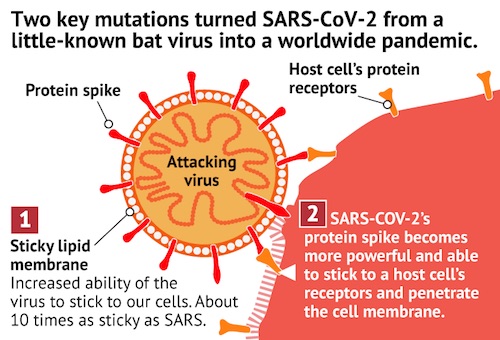

Health care for profit.
• US Health Care Failed To Heed Repeated Warnings Of Supply Shortages (JTN)
As the Bush administration entered its final months in office, its Occupation Safety and Health Administration examined whether hospitals were prepared to protect frontline doctors and nurses in the event of a catastrophic viral pandemic. The nation was four years removed from the scare of the SARS coronavirus and two years removed from the creation of a national pandemic plan designed to heighten awareness and preparedness. What OSHA found was not only alarming, but prescient to the crisis America now endures in 2020. “It is expected that there will be a worldwide shortage of respirators if and when a pandemic occurs. Employers and employees should not count on obtaining any additional protective equipment not already purchased and stockpiled,” OSHA warned in a report.
OSHA’s warning to stockpile was not an isolated event. A Just the News review found more than a dozen government investigations, congressional reports and pandemic preparedness reviews dating to the 1990s warned that America’s health care system was woefully unprepared for a fast-moving outbreak. But the pleas of stockpiles, better training, better coordination and more testing of potential remedies fell on the deaf ears of policymakers, congressional overseers and hospital administrators and the chronic inertia in Washington, according to experts who raised the alarm.
“Hospitals were focused on their bottom lines to make more money and not addressing an issue that was going to cost them money in the long run and save lives,” said former Rep. Chris Shays, R-Conn., who called attention to the gaps in America’s pandemic preparedness with hearings. “Everyone knew from the White House to Congress – Democrats and Republicans – everyone knew this was becoming a very serious problem.” The tragic scenes playing out in emergency rooms in New York and elsewhere, where nurses are making gowns from garbage bags and doctors are washing used respirator masks in bleach in hopes of sterilizing and recycling them, did not have to be, as The New York Times columnist Farhad Manjoo aptly noted a few days ago.
“The answer to why we’re running out of protective gear involves a very American set of capitalist pathologies — the rise and inevitable lure of low-cost overseas manufacturing, and a strategic failure, at the national level and in the healthcare industry, to consider seriously the cascading vulnerabilities that flowed from the incentives to reduce costs,” the columnist wrote. The crisis sweeping America was not one of surprise. The warnings and plannings were repeatedly offered. The crisis is one of past inaction, the experts say.

“In a few short weeks, everything has changed — people’s habits, their hobbies, their social life, their reality. School corridors lie empty. Paintings in art classes are left unfinished.”
• Italians Wait For The Coronavirus Surge To Finally Peak (MW)
Our world has been turned outside in. It’s now almost six weeks since the university in Milan has been closed, and three weeks since the official lockdown was announced. We have daily music lessons in the bedroom, English lessons in the kitchen and high-school classes in the living room. As a language teacher, I have been literally run off my fingers. Moving courses online has been a mammoth task, and there have been barely enough hours in the day to get things done. But now, six weeks in, the workload is finally easing off. The number of coronavirus contagions here in Italy, on the other hand, is not. My area of Lombardy is still the worst affected, accounting for over a third of the 97,689 nationwide cases to date, with 969 deaths reported in just one day.
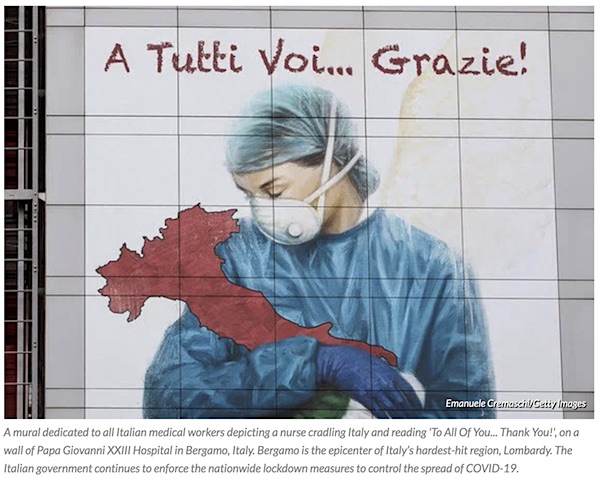
The peak we had been expecting two weeks ago has yet to arrive and, according to Silvio Brusaferro, Commissario Straordinario of the Istituto Superiore di Sanità, warned Friday, “We have neither reached it, nor surpassed it.” There are the faintest glimmers of hope. The number of confirmed cases reached 97,689 on Sunday, up from 92,472 the day before. That was the lowest increase in infections since last Wednesday. The rise in the number of deaths from COVID-19, the disease caused by the novel coronavirus, slowed on Sunday for the second consecutive day. As of Sunday, the virus has killed 10,779 people in Italy, accounting for one-third of the worldwide total number of fatalities (33,968), and is more than three times the number of deaths from the virus in the U.S. (2,489).
“The measures that were due to expire on April 3 inevitably will be extended,” Regional affairs minister Francesco Boccia told Sky TG24 television on Sunday. Prime Minister Giuseppe Conte will ultimately make that decision, he said. People are, for the most part, resigned to the fact that they have to wait the lockdown out. Some people who have relatives who tested positive or are in high-risk groups are going into extended quarantine, so still having to rely on friends and family to replenish their supplies.

Well, we can dream.
• Six Months Before We Can Return To ‘Normal Life’ (Ind.)
Britain has been braced to expect a partial lockdown of society “for six months or longer”, following another sharp rise in the number of coronavirus deaths. Only “some” of the harsh restrictions will be lifted in the weeks to come, the deputy chief medical officer warned – even if a review after Easter judged they are working. “Three weeks for review, two or three months to see if we’ve really squashed it,” Dr Jenny Harries told a Downing Street press conference. “But three to six months, ideally – but lots of uncertainty in that – to see at which point we can actually get back to normal. And it is plausible it could go further than that.”
In a bleak message – on the day a further 209 deaths were announced, taking the UK total to 1,228 – the deputy chief medical officer warned it would be “dangerous” to revert to normal too quickly. “If we stop, then all of our efforts will be wasted and we could potentially see a second peak,” she urged the public to recognise. The comments came as Robert Jenrick, the communities secretary, said all parts of the UK were now on an “emergency footing”, a status unprecedented in peacetime. [..] Ms Harries said that, although the review would take place after Easter, it would then be two to three months before it was possible to judge if the NHS had “squashed the peak” of coronavirus cases.
“We anticipate our numbers will get worse over the next week, possibly two, and then we are looking to see whether we have managed to push that curve down and we start to see a decline,” she told the press conference. “This is not to say we would be in complete lockdown for six months, but, as a nation, we have to be really, really responsible and keep doing what we’re all doing until we’re sure we can gradually start lifting various interventions.” That lifting would be “spaced, based on the science and our data, until we gradually come back to a normal way of living”.

How was it again? They can’t be prosecuted while sitting?
• DoJ Reviews Stock Trades By Lawmakers After Coronavirus Briefings (R.)
The Justice Department has started to probe a series of stock transactions made by lawmakers ahead of the sharp market downturn triggered by the coronavirus pandemic, CNN reported on Sunday, citing two people familiar with the matter. The inquiry is still in its early stages and being done in coordination with the U.S. Securities and Exchange Commission, according to the report. The FBI has reached out to at least one lawmaker, U.S. Republican Senator Richard Burr, seeking information about the trades, CNN reported, citing one of the sources. Earlier this month, Burr said he relied solely on news reports to guide decisions on stock sales, amid reports he and other senators sold off shares after being briefed on the risks of the coronavirus crisis.

“Perhaps the key is how long the ordinary folk agree to their orderly confinement..”
• Forced Liquidation (Kunstler)
The world is locked down and in hock up to its eyeballs. It faces what the bankers euphemistically call, ahem, a “work-out,” which is to say, a restructuring. The folks in charge are resisting that work-out with all their might, because it will change many of the conditions of everyday life (especially theirs), but it is coming anyway. When debt can’t be paid back, money vanishes. Money isn’t capital, but it represents capital when it is functioning. When it isn’t functioning, it stops being money. Now the whole world realizes that the debt can’t be paid back, will never be paid back… and that’s the jig that’s up.
The Federal Reserve’s balance sheet is the black hole in the financial universe where money goes to die. Money is rushing in there at a fantastic rate these days, and the Fed is trying to spew out new money at an equal rate to replace it – raising the question: is it even money anymore, or just a figment in the larger hallucination? Kind of seems that way, a little bit. They brought out their biggest money-launching bazookas only a few days ago, and it may only be few days more before that gigantic salvo proves inadequate. What then?
Perhaps the key is how long the ordinary folk agree to their orderly confinement, even in the face of the corona virus. That moment may be a bit further out, with the melodrama mounting especially in New York City right now, numbers of sick people going all hockey-stick, and frightful scenes in the hospitals. But then, whether it’s a week from now, or Easter Sunday, or sometime after that, what will the ordinary folk do when they decide en masse to de-confine and come roaring out in the streets?

Hey, hey, there’ll be no shooting the messenger. I didn’t write this. Or do it.
• Astrophysicist Gets Magnets Stuck Up Nose While Inventing Virus Device (G.)
An Australian astrophysicist has been admitted to hospital after getting four magnets stuck up his nose in an attempt to invent a device that stops people touching their faces during the coronavirus outbreak. Dr Daniel Reardon, a research fellow at Melbourne’s Swinburne University, was building a necklace that sounds an alarm on facial contact, when the mishap occurred on Thursday night. The 27 year-old astrophysicist, who studies pulsars and gravitational waves, said he was trying to liven up the boredom of self-isolation with the four powerful neodymium magnets. “I have some electronic equipment but really no experience or expertise in building circuits or things,” he told Guardian Australia.
“I had a part that detects magnetic fields. I thought that if I built a circuit that could detect the magnetic field, and we wore magnets on our wrists, then it could set off an alarm if you brought it too close to your face. A bit of boredom in isolation made me think of that.” However, the academic realised the electronic part he had did the opposite – and would only complete a circuit when there was no magnetic field present. “I accidentally invented a necklace that buzzes continuously unless you move your hand close to your face,” he said. “After scrapping that idea, I was still a bit bored, playing with the magnets. It’s the same logic as clipping pegs to your ears – I clipped them to my earlobes and then clipped them to my nostril and things went downhill pretty quickly when I clipped the magnets to my other nostril.”
Reardon said he placed two magnets inside his nostrils, and two on the outside. When he removed the magnets from the outside of his nose, the two inside stuck together. Unfortunately, the researcher then attempted to use his remaining magnets to remove them. “At this point, my partner who works at a hospital was laughing at me,” he said. “I was trying to pull them out but there is a ridge at the bottom of my nose you can’t get past. “After struggling for 20 minutes, I decided to Google the problem and found an article about an 11-year-old boy who had the same problem. The solution in that was more magnets. To put on the outside to offset the pull from the ones inside. “As I was pulling downwards to try and remove the magnets, they clipped on to each other and I lost my grip. And those two magnets ended up in my left nostril while the other one was in my right. At this point I ran out of magnets.”

It must be possible to run a joint like the Automatic Earth on people’s kind donations. These are no longer the times when ads pay for all you read, your donations have become an integral part of it. It has become a two-way street; and isn’t that liberating, when you think about it?
Thanks everyone for your wonderful and generous donations over the past days.




Jennifer Baer

Support us in virustime. Help the Automatic Earth survive. It’s good for you.







